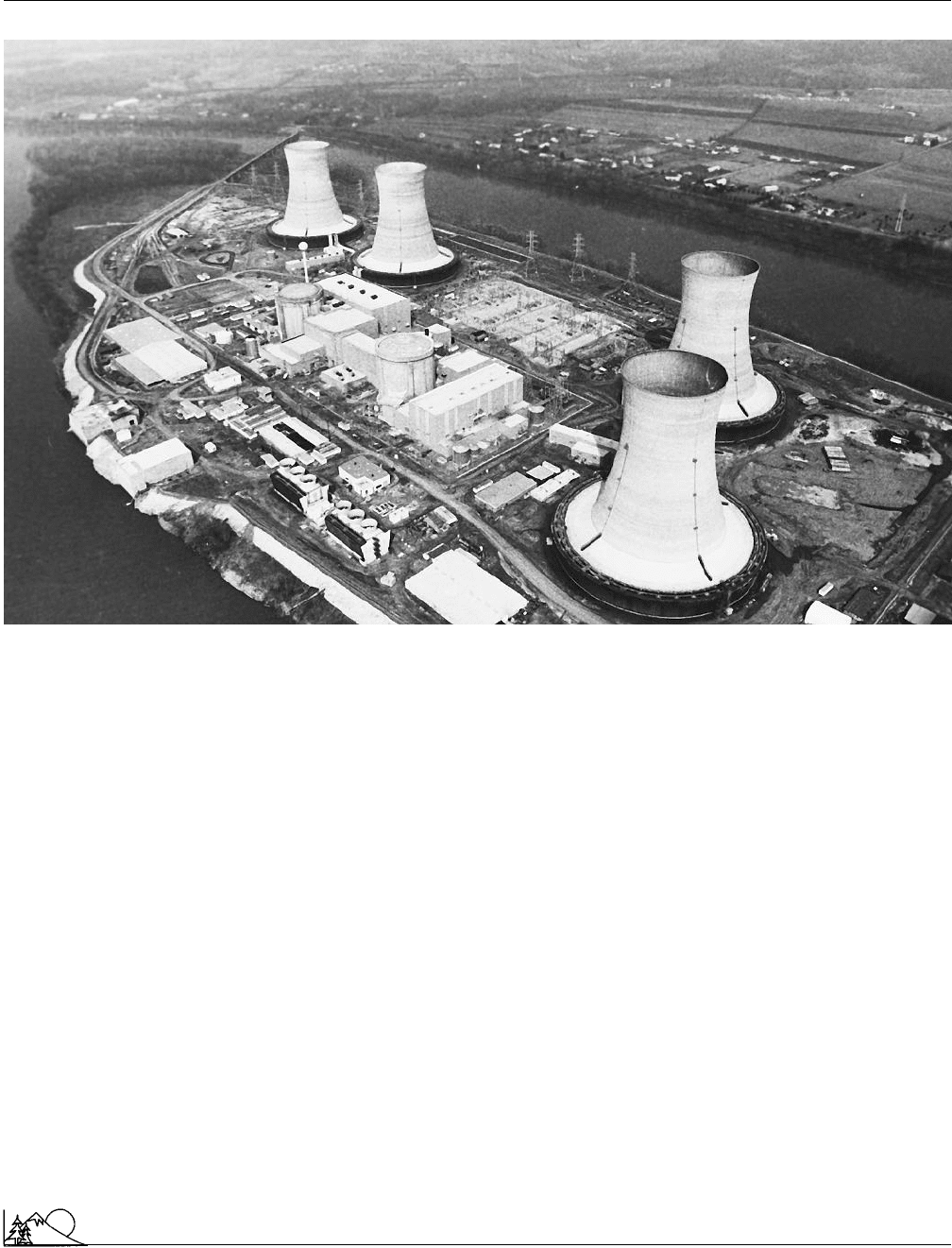Environmental Encyclopedia
Подождите немного. Документ загружается.


Environmental Encyclopedia 3
Three Gorges Dam
Henry David Thoreau. (The Library of Congress.)
but he did not own it or have to pay taxes or upkeep on it;
he “borrowed” it from his friend Ralph Waldo Emerson
(1803–1882). It is not realistic for most people to try to
emulate Thoreau directly or to take his suggestions literally.
And he agreed, saying “I would not have anyone adopt my
mode of living on any account.” Still, he did figure out that
by working only six weeks a year, he could support himself
and so free the other forty-six to live as he saw fit.
Often characterized as an impractical dreamer, Tho-
reau’s wisdom is repeated widely today, a wisdom that is
commonly of direct applicability and down to earth.
Aldo
Leopold
, for example, is credited with the axiom that wood
you cut yourself warms you twice, but it can be found almost
a hundred years earlier in Thoreau’s chapter on “House-
Warming.” In 1850, he was an advocate of
national forest
preserves, writing eloquently on the subject in his essay
“Chesuncook” in The Maine Woods. He also predicted the
devastation wreaked on the shad runs by
dams
built on the
Concord River.
Thoreau was first and finally a writer. His greatest
contribution remains that his writing still raises the con-
sciousness of the reader, causing people who come in contact
with his work to be more aware of themselves and of the
world around them. As he said “only that day dawns to which
we are awake.” A raised consciousness means an increase in
humility because, as Thoreau teaches, “the universe is wider
1397
than our views of it.” He remained convinced “that to main-
tain one’s self on this earth is not a hardship but a pastime.”
[Gerald L. Young]
R
ESOURCES
B
OOKS
Fritzell, P. A. “Walden and Paradox: Thoreau as Self-Conscious Ecologist.”
In Nature Writing and America: Essays Upon a Cultural Type. Ames: Iowa
State University Press, 1990.
Johnson Jr., W. C. “Thoreau’s Language of Ecology.” In Wilderness Tapestry:
An Eclectic Approach to Preservation, edited by S. I. Zeveloff, L. M. Vause,
and W. H. McVaugh. Reno: University of Nevada Press, 1992.
Thoreau, H. D. Walden. New York: A. L. Burt, 1902.
Threatened species
see
Endangered species
Three Gorges Dam
When finished in 2009, the Three Gorges Dam on the
Chang Jiang (Yangtze River) will be the largest dam in the
world. Spanning 1.2 mi (2.0 km), and standing 600 ft (175
m) above normal river level, the dam will create a
reservoir
more than 400 mi (644 km) long. The project was designed
to control floods, ease navigation, and provide badly needed
electricity for China’s heartland. The 26 giant turbines in
the dam’s powerhouse are expected to generate 18,200 mega-
watts of electricity—equal to 10% of the country’s current
supply—to support industrialization and modernization in
the region. The reservoir will flood the scenic Three Gorges,
one of China’s most historically significant areas. It also will
displace at least 1.3 million people and will flood 150 towns
and cities, and more than 1,300 villages.
Proponents of the project argue that China needs the
project’s electricity for modernization. With dangerous rap-
ids drowned under the reservoir, ocean-going ships will be
able to sail all the way to Chongking, nearly 2,000 mi (3,200
km) inland from the ocean. The water stored in the reservoir
also will make possible a long-discussed plan to build aque-
ducts to carry water from southern China to the dry plains
around Beijing. Furthermore, annual
flooding
on the river
caused 300,000 deaths in the twentieth century. In 1998,
the worst flood in history drove 56 million people from their
homes. Planners expect the dam to reduce these floods and
eliminate untold misery for the 300 million people who live
in the Yangtze River Valley.
The Three Gorges Dam was first proposed in 1919
by Dr. Sun Yat-sen, a revolutionary and founder of the
Chinese republic. Later it was championed by Mao Tse-
tung (or Zedong) who led the country from 1949 to 1976.

Environmental Encyclopedia 3
Three Mile Island Nuclear Reactor
Mao saw this project as a way to instill national pride and
demonstrate China’s modernization. Although Mao ordered
a full-scale survey and project design in 1955, prohibitive
costs together with doubts about the safety and feasibility
of the dam have slowed construction. In 1992, Premier Li
Peng pushed through the final vote to authorize the project.
The first stage of construction was completed in 2002, and
flooding of the reservoir will begin in 2003. The water is
expected to reach its maximum height by 2009.
Environmentalists criticize the dam on the grounds
that it will reduce fish stocks, eliminate 78,000 acres (32,000
ha) of important agricultural lands, and threaten habitats of
critically
endangered species
such as the Yangtze river
dolphin, Chinese sturgeon, finless porpoise, and Yangtze
alligator. The reservoir will also fill one of China’s most
important historical and cultural regions, sinking 8,000 ar-
cheological sites and historic monuments. Currently, more
than 250 billion gallons (nearly a trillion liters) of untreated
sewage is dumped into the Yangtze every year. Planners
claim that the new cities into which residents are being
relocated will have better
sanitation
than the old river
towns. How sewage is handled in these new towns, and how
much contamination leeches out of abandoned structures in
the reservoir remains to be seen. Environmentalists worry
that the reservoir will become a stagnant cesspool, dangerous
to both aquatic life and to the millions of people who depend
on the river for their drinking water.
Sediment
and
silt
accumulation is another problem
to be solved, since tremendous volumes of sediment will
accumulate as the silt- and sand-laden Yangtze River slows
in the reservoir. Elsewhere in China silt and sand accumula-
tion has decreased reservoir storage capacity nationwide by
14%. Simply controlling river-bottom gravel may require
dredging
as much as 200,000 m
2
of material each year. To
reduce sediment accumulation, dam operators plan to let
spring floods, which carry much of the annual sediment
load, flow through silt doors at the bottom of the dam. They
hope this flow will scour out the bottom of the reservoir.
Geologists worry about catastrophic dam failure be-
cause the dam is built over an active seismic fault. Engineers
assure us that the dam can withstand the maximum expected
earthquake
, but China has a poor record of dam safety.
More than 3,200 Chinese
dams
have failed since 1949, a
failure rate of 3.7% compared to a 0.6% failure rate for the
rest of the world. Probably the worst series of dam failures
in world history occurred in Henan Province in 1975, when
heavy
monsoon
rains caused 62 modern dams to fall like
a line of dominoes. Some 230,000 people died in the massive
flooding that followed. Even if the dam is able to withstand
earthquakes, giant waves spawned by upstream landslides
could easily cause a calamitous dam failure. In 1986, a
land-
slide
just a few miles upstream from the dam site dumped
1398
15 million cubic meters of rock and
soil
into the river.
Witnesses reported an 260 ft (80 m) wave rolling down the
river. If a wave that size hits the upstream side of the dam
with a full reservoir, one geologist predicts a flood “of biblical
proportions” as a wall of water races downstream through
lowlands where hundreds of millions of people live.
The Chinese government is installing an early warning
system to predict landslides, and has banned timber cutting
and farming on steep upstream hillsides in an effort to control
both landslides and sediment loads in the river. Critics claim
that there would be safer and cheaper ways to store water
and generate electricity than a single huge dam. Original
estimates were that the Three Gorges Dam would cost $11
billion. By 2002, the costs for construction, relocation, and
landscape stabilization had risen to $75 billion, and the
project is not yet finished. A series of relatively small dams
on tributary streams might have been much cheaper and less
disruptive than the current project.
In 2002, the first stage of the dam was completed and
water started filling the reservoir. By late 2003, the water is
expected to reach a height of 438 ft (135 m) above normal
river level. Most of the new cities above the final 175 m
watermark have already been finished, and relocation of
residents is well underway. Destruction and decontamination
of cities that will be flooded has also begun.
[William P. Cunningham Ph.D.]
R
ESOURCES
B
OOKS
Dai Qing. The River Dragon Has Come! Armonk, New York: M. E.
Sharpe, 1998.
Hessler, Peter. River Town: Two Years on the Yangtze. New York: Harper-
Collins, 2001.
Leopold, Luna. Sediment Problems at Three Gorges Dam. Berkely, CA:
International Rivers Network, 1996.
Ryder, Grainne, ed. Damming the Three Gorges: What the Dam Builders
Don’t Want You to Know. Toronto: Probe International, 1990.
P
ERIODICALS
Sullivan, L. R. “The Three Gorges Project: Dammed If They Do?” Curent
History 94 (1995): 266–70.
Three Mile Island Nuclear Reactor
The 1970s were a decade of great optimism about the role of
nuclear power
in meeting world and national demands for
energy. Warnings about the declining reserves of
coal
,
petro-
leum
, and
natural gas
, along with concerns for the environ-
mental hazards posed by
power plants
run on
fossil fuels
,
fed the hope that nuclear power would soon have a growing
role in energy production. Those expectations were suddenly
and dramatically dashed on the morning of March 28, 1979.

Environmental Encyclopedia 3
Three Mile Island Nuclear Reactor
An aerial view of Three Mile Island Nuclear Reactor in Harrisburg, Pennsylvania. (AP/Wide World Photos. Reproduced
by permission.)
On that date, an unlikely sequence of events resulted
in a disastrous accident at the Three Mile Island (TMI)
Nuclear Reactor at Harrisburg, Pennsylvania. As a result of
the accident, radioactive water was released into the Susque-
hanna River, radioactive steam escaped into the
atmo-
sphere
, and a huge bubble of explosive
hydrogen
gas filled
the reactor’s cooling system. For a period of time, there
existed a very real danger that the reactor core might melt.
News of the accident produced near panic among resi-
dents of the area. Initial responses by government and indus-
try officials downplayed the seriousness of the accident and,
in some cases, were misleading and self-serving.
The first official study of the TMI accident was carried
out by the President’s Commission on the Accident at Three
Mile Island. Chaired by John G. Kemeny, then president
of Dartmouth College, the Commission attempted to recon-
struct the events that led to the accident. It found that the
accident was initiated during a routine maintenance opera-
tion in which a water purifier used in the system was replaced.
Apparently air was accidentally introduced into the system
along with the purified fresh water.
1399
Normally the presence of a foreign material in the
system would be detected by safety devices in the reactor.
However, a series of equipment malfunctions and operator
errors negated the plant’s monitoring system and eventually
resulted in the accident.
At one point, for example, operators turned off emer-
gency cooling pumps when faulty pressure gauges showed
that the system was operating normally. Also, tags which
hung on water pumps indicating that they were being re-
paired blocked indicator lights showing an emergency condi-
tion inside the reactor.
The Kemeny Commission placed blame for the TMI
accident in a number of places. They criticized the nuclear
industry and the
Nuclear Regulatory Commission
for be-
ing too complacent about reactor safety. They suggested that
workers needed better training. The Commission also found
that initial reactions to the accident by government and
industry officials were inadequate.
No one was killed in the TMI accident, but a 1990
study showed that there were no statistically significant in-

Environmental Encyclopedia 3
Threshold dose
creases in cancers for residents downwind of the accident.
A study completed in the mid-1990s, however, refutes those
findings stating that “cancer incidence, specifically, lung
can-
cer
and
leukemia
, increased more following the TMI acci-
dent in areas estimated to have been in the pathway of
radioactive plumes than in other areas.” This study also
indicates that the radiation levels may have been higher than
originally reported, and that cancer rates (lung/leukemia)
were 2–10 times higher than upwind rates. Cleanup opera-
tions at the plant took over six years to complete, and with
a $1 billion price tag, cost more than the plant’s original
construction.
Probably the greatest effect of the TMI accident was
the nation’s loss of confidence in nuclear power as a source
of energy. Since the accident, not one new nuclear power
plant has been ordered, and existing plans 65 others were
eventually canceled. See also Carcinogen; Radiation exposure;
Radioactive waste; Radioactivity
[David E. Newton]
R
ESOURCES
B
OOKS
Dresser, P. D. Nuclear Power Plants Worldwide. Detroit, MI: Gale Re-
search, 1993.
Ford, D. Three Mile Island: Thirty Minutes to Meltdown. New York: Pen-
guin, 1983.
Gray, M., and I. Rosen. The Warming: Accident at Three Mile Island. New
York: W.W. Norton, 1982.
Moss, T. H., and D. L. Sills, eds. The Three Mile Island Nuclear Accident:
Lessons and Implications. New York: Academy of Sciences, 1981.
P
ERIODICALS
Booth, W. “Post-Mortem on Three Mile Island.” Science (December 4,
1987): 1342–1345.
Stranahan, S. Q. “Three Mile Island: It’s Worse Than You Think.” Science
Digest (June 1985): 54–57+.
O
THER
President’s Commission on the Accident at Three Mile Island. Report of
the President’s Commission on the Accident at Three Mile Island. Washington,
DC: U.S. Government Printing Office, 1979.
Threshold dose
In radiology, the threshold dose is the smallest dose of radia-
tion that will produce a specified effect. In the larger context
of toxic exposure, threshold dose refers to the dose below
which no harm is done. There is a threshold below which
relatively little damage occurs from exposure, and above
which the damage increases dramatically. For noncarcino-
genic
toxins
, there does seem to be a safe dose for some
substances, a threshold dose below which no harm is done.
With carcinogens, however, just one change in the genetic
materials of one cell may be enough to cause a malignant
1400
transformation that can lead eventually to
cancer
. Although
there is some evidence that repair mechanisms or surveillance
by the immune system may reduce the incidence of some
cancers, it is generally considered prudent to assume that
no safe or threshold dose exists for carcinogens.
Tidal power
In looking for
alternative energy sources
to meet future
needs, some common physical phenomena are obvious can-
didates. One of these is tidal power. Twice each day on
every coastline in the world, bodies of water are pulled onto
and off of the shore as a result of gravitational forces exerted
by the moon and sun. Only on ocean coasts is this change
large enough to notice, however, and therefore, to take ad-
vantage of as an energy source.
The potential of tidal power as an energy source is
clearly demonstrated. Pieces of wood are carried onto a beach
and then off again every time the tide comes in or goes out.
In theory, the energy that moves this wood could also push
against a turbine blade and turn a generator.
In fact, the number of places on the earth where
tides are strong enough to spin a turbine is relatively
small. The simple back-and-forth movement seen on any
shoreline does not contain enough energy by itself. Geo-
graphical conditions must concentrate and focus tidal action
in a limited area. In such places, tides do not move in
and out at a leisurely pace, but rush in and out with the
force of a small river.
One of the few commercial tidal power stations in
operation is located at the mouth of La Rance River in
France. Tides at this location reach a maximum of 44 ft
(13.5 m). Each time the tide comes in, a dam at the La
Rance station holds water back until it reaches its maximum
depth. At that point, gates in the dam are opened and water
is forced to flow into the river, driving a turbine and generator
in the process. Gates in the dam are then closed, trapping
the water inside the dam. At low tide, the gates open once
again, allowing water to flow out of the river, back into the
ocean. Again the power of moving water is used to drive a
turbine and generator.
Hence the plant produces electricity only four times
each day, during each of two high tides and each of two
low tides. Although it generates only 250 megawatts daily,
the plant’s 25% efficiency rate is about equal to that of a
power plant operating on
fossil fuels
.
One area where tides are high enough to make a power
plant feasible is on Canada’s
Bay of Fundy
. Experiments
suggest that plants with capacities of 1–20 megawatts could
be located at various places along the bay. So far, however,
the cost of building such plants is significantly greater than

Environmental Encyclopedia 3
Tigers
the cost of building conventional
power plants
of similar
capacity. Still, optimists suggest that serious development
of tidal power could provide up to a third of the electrical
energy now obtained from hydropower worldwide at some
time in the future.
Despite the drawbacks and expense of tidal power,
China is one country that has used it extensively. Since
energy needs are often modest in China, low capacity plants
are more feasible. As of the late 1980s, therefore, the Chinese
had built more than 120 tidal power plants to provide elec-
tricity for small local regions. See also Dams; Energy and
the environment; Wave power
[David E. Newton]
R
ESOURCES
P
ERIODICALS
Greenburg, D. A. “Modeling Tidal Power.” Scientific American 257 (No-
vember 1987): 128–135.
Holloway, T. “Tidal Power.” Sea Frontiers 35 (March-April 1989): 114–49.
“The Potential of Tidal Power—Still All At Sea.” New Scientist 126 (May
19, 1990): 52.
Webb, J. “Tide of Optimism Ebbs Over Underwater Windmill.” New
Scientist 138 (April 24, 1993): 10.
Tigers
Tigers (Panthera tigris) are the largest living members of the
family Felidae, which includes all cats. Siberian tigers (P. t.
altaica) are the largest and most massive of the eight recog-
nized subspecies. They normally reach a weight of 660 lb
(300 kg), with a record male that reached 845 lb (384 kg).
Several of the subspecies have had their populations totally
decimated and are probably extinct, mostly through direct
human actions. The species’ range, overall, has been greatly
reduced in historic times. Currently, tigers are found in
isolated regions of India, Bangladesh, Nepal, Bhutan, South-
east Asia, Manchuria, China, Korea, Russia, and Indonesia.
Tigers are designated “endangered” by the U. S.
Fish and
Wildlife Service
and by
IUCN—The World Conservation
Union
. They are also listed in Appendix I of the
Convention
on International Trade in Endangered Species of Wild
Fauna and Flora
.
Unlike their relatives, the lion and the cheetah, tigers
are not found in open habitats. They tend to be solitary
hunters, stalking medium- to large-sized prey (such as pigs,
deer, antelope, buffalo, and gaur) in moderately dense cover
of a variety of forest habitats, including
tropical rain forest
,
moist coniferous and deciduous forests, dry forests, or man-
grove swamps. Within their
habitat
both males and females
establish home ranges that do not overlap with members of
their own sex. Home ranges average 8 mi
2
(21 km
2
) for
1401
females, but vary from 25–40 mi
2
(65–104 km
2
) for males
depending on prey availability and to allow for the inclusion
of several females in his range. Tigers that live in areas of
prime habitat raise more offspring than can establish ranges
within that habitat, therefore, several are forced to the pe-
riphery to establish territories and live. This creates an im-
portant condition in that this series of peripheral individuals
helps promote genetic mixing in the breeding population.
Tigers are often labeled “maneaters.” Although most
tigers shy away from humans, some have been provoked
into attack. Others, having been encountered unexpectedly,
attack people as a defense, and a very few are thought to
hunt humans consciously. An estimated 60–120 people fall
victim to tigers each year. Tigers’ typical prey includes larger
mammals such as deer and buffalo, and the cats will actively
search for this prey, instead of waiting in ambush. Tigers
hunt alone, and, even though they are highly skilled preda-
tors, are rarely successful more than once in every 15 at-
tempts. With a
scarcity
of habitat for large prey and reduced
cover, many tigers will opportunistically attack domesticated
livestock, thus, themselves becoming targets of humans.
Population pressures from humans, habitat loss,
poaching
, and
overhunting
have led to the
extinction
or
probable extinction of four subspecies and large reductions
in the populations of the other four subspecies of tiger.
The Balinese tiger (P. t. balica) has been extinct for several
decades. The South China tiger (P. t. amoyensis), which was
the target of an extermination campaign, may be extinct in
the wild. There has been only one unconfirmed report of
the Caspian tiger (P. t. virgata) in the last 30 years, thus it
is probably extinct. The Javan tiger (P. t. sondiaca) is also
probably extinct, as its population was reduced to four or
five individuals, and there has not been a confirmed sighting
since the late 1970s. Little is known of the population levels
of the Indochinese tiger (P. t. corbetti) but the number is
thought to be between 1,000 and 1,500, with 60 in captivity.
The Sumatran tiger (P. t. sumatrae) has a population in the
wild of about 500 individuals. The Siberian tiger, whose
population dropped to 20–30 individuals in 1940, has a
population today of over 500 in the wild. The Bengal tiger
(P. t. tigris) has been the target of renewed poaching efforts
since mid-1990. The bones of these tigers bring a handsome
price on the black market. Tiger bones are ground up, dis-
solved in a liquid, and used in Chinese medicine. Early
estimates are that 500 or more Bengal tigers have been
poached in the last three years for this purpose.
[Eugene C. Beckham]
R
ESOURCES
B
OOKS
Grzimek, B., ed. Grzimek’s Encyclopedia of Mammals. Vol. 4. New York:
McGraw-Hill, 1990.

Environmental Encyclopedia 3
Tilth
Nowak, R. M. Walker’s Mammals of the World. 6th ed. 2 vols. Baltimore:
Johns Hopkins University Press, 1999.
P
ERIODICALS
Angier, Natalie. “The Cat Comes Back.” New York Times Upfront (January
31, 2000): 24.
Luoma, J. R. “The State of the Tiger.” Audubon 89 (1987): 61–63.
“Man Saving Endangered Tigers.” Xinhua News Agency (March 15, 2001).
O
THER
The Tiger Foundation. [cited May 2002]. <http://www.tigers.ca>.
Tilth
Tilth is the ability of the
soil
to facilitate tillage, resist weeds,
and allow plants to take root. It can also refer to the act of
tilling, or cultivating soil. Some have related soil tilth to the
physical condition of the soil created by integrating the
effects of all physical, chemical, and biological processes
occurring within a soil matrix. Soil tilth is usually used as a
general descriptive term (good, moderate, or poor) rather
than a precisely defined scientific quotient. See also Agricul-
tural chemicals; Arable land; Soil fertility
Timberline
The elevational or latitudinal extent of forests. Above upper
timberline, either at high elevations or at the Arctic or Ant-
arctic limits, atmospheric and
soil
temperatures are too cold
for forest development. Below lower timberline, conditions
are too dry to support forests. Timberlines are more common
and pronounced in the western than in the eastern United
States because of more extreme topographic and climatic
conditions in the West.
Times Beach
More than 2,000 residents of this Missouri town, located
about 30 mi (48 km) southwest of St. Louis, were evacuated
after it was contaminated with
dioxin
. In 1971, chemical
wastes containing dioxin were mixed with oil and sprayed
along the streets of Times Beach to keep down the dust.
The spraying was done by Russell M. Bliss, whose company
collected and disposed of waste oils and
chemicals
from
service stations and industrial plants. Much of this toxic
waste oil was sprayed on roads throughout Missouri.
Shortly after the spraying around Times Beach, horses
on local farms began dying mysteriously. At one breeding
stable, from 1971 to 1973, 62 horses died, as well as several
dogs and cats.
Soil
samples were sent to the Centers for
Disease Control (CDC) in Atlanta for analysis, and after
1402
three years of testing, the agency determined that dangerous
levels of dioxin were present in the soil.
A decade after the spraying, the town experienced the
worst
flooding
in its history. On December 5, 1982, the
Meramec River flooded its banks and inundated the town,
submerging homes and contaminating them and almost ev-
erything else in Times Beach with dioxin. This compound
binds tightly to soil and degrades very slowly, so it was still
present in significantly high levels ten years after being used
on the roads as a dust suppressant. Following a CDC warn-
ing that the town had become uninhabitable, most of the
families were temporarily evacuated. The U.S.
Environmen-
tal Protection Agency
(EPA) eventually agreed to buy out
the town for about $33 million and relocate its inhabitants.
At the time, the CDC considered soil dioxin levels of
one part per billion (ppb) and above to be potentially hazard-
ous to human health. Levels found in some areas of Times
Beach reached 100 to 300 ppb and above. Dioxin is consid-
ered a very toxic chemical. Exposure to this chemical has
been linked to
cancer
, miscarriages, genetic mutations, liver
and nerve damage, and other health effects, including death,
in humans and animals.
Indeed, the contamination seemed to take a serious
toll on the health of Times Beach residents. Town officials
claimed that virtually every household in Times Beach expe-
rienced health disorders, ranging from nosebleeds, depres-
sion, and chloracne (a severe skin disorder) to cancer and
heart disease. Almost all of the residents tested for dioxin
contamination showed abnormalities in their blood, liver,
and kidney functions.
By 1983, federal and state officials had located about
100 other sites in Missouri where dioxin wastes had been
improperly dumped or sprayed, with levels of the compound
reaching as high as 1,750 ppb in some areas.
A decade after the evacuation of Times Beach, debate
over dioxin’s dangers continues, and some CDC officials
now say that the agency overreacted and that the town should
not have been abandoned. But by then, Times Beach had
become a household name, joining
Love Canal
, New York,
and
Seveso, Italy
, on the list of municipalities that were
ruined by toxic chemical contamination. See also Carcinogen
[Lewis G. Regenstein]
R
ESOURCES
P
ERIODICALS
“Dioxin Cleanup: Status and Opinions.” Science News 141 (January 11,
1992): 30.
Felton, E. “The Times Beach Fiasco.” Insight 7 (August 12, 1991): 12–19.
Gorman, C. “The Double Take on Dioxin.” Time 138 (August 26,
1991): 52.
Kemezis, P. “Times Beach Cleanup Begins.” ENR 225 (August 2, 1990):
37–8.

Environmental Encyclopedia 3
Toilets
Tipping fee
The fee charged by the owner or operator of a
landfill
for
the acceptance of a unit weight or volume of
solid waste
for disposal, usually done by the truckload. The tipping fee
is passed back along the chain of waste acceptor to hauler
to generator in the form of fees or taxes. Tipping fees rise
as the volume of available landfill space is depleted, or as it
becomes harder to open new landfills due to public opposi-
tion and stricter environmental regulations. See also Garbage;
Municipal waste; Transfer station; Waste management;
Waste stream
Tobacco
Tobacco (Nicotiana tabacum) is an herbaceous plant culti-
vated around the world for its leaves, which can be rolled
into cigars, shredded for cigarettes and pipes, processed for
chewing, or ground into snuff. Tobacco leaves are the source
of commercial nicotine, a component of many pesticides.
The tobacco plant is fast-growing with a stem from 4–8 ft
(1–3 m) in height.
Native to the Americas, tobacco was cultivated by
Native Americans, and Christopher Columbus found them
using it in much the same manner as today. American Indi-
ans believed it to possess medicinal properties, and it was
important in the ceremonies of the plains tribes.
Tobacco was introduced into Europe in the mid-1500s
on the basis of its purported medicinal qualities. Tobacco
culture by European settlers in America began in 1612 at
Jamestown, and it soon became the chief commodity ex-
changed by colonists for articles manufactured in Europe.
The leading tobacco-growing countries in the world
today are China and the United States, followed by India,
Brazil, and Turkey, as well as certain countries in the former
Soviet Union. Although about one-third of the annual pro-
duction in the United States is exported, the country also
imports about half as much tobacco as it exports. The leading
tobacco-growing state is North Carolina, followed by Ken-
tucky, South Carolina, Tennessee, Virginia, and Georgia.
Nicotine occurs in tobacco along with related alkaloids
and organic acids such as malic and citric. Nicotine content
is determined by the
species
, variety, and strain of tobacco;
it is also affected by the growing conditions, methods of
culture and cure, and the position on the plant from which
the leaves are taken. Tobacco is high in ash content, which
can range from 15–25% of the leaf. Flue-cured tobacco is
rich in sugar, and cigar tobaccos are high in nitrogenous
compounds but almost free of starch and sugars.
Most tobacco products are manufactured by blending
various types of leaves, as well as leaves of different origins,
1403
grades, and crop years. Cigarette manufacturers usually add
sweetening preparations and other flavorings, but the prepa-
ration of tobaccos for pipe smoking and chewing is as varied
as the assortment of products themselves. Snuff is made by
fermenting fire-cured leaves and stems and grinding them
before adding salts and other flavorings. Cigars are made by
wrapping a binder leaf around a bunch of cut filler leaf and
overwrapping with a fine wrapper leaf.
In the United States and elsewhere, stems and scraps
of tobacco are used for nicotine extractions. They can also
be ground down and made into a reconstituted sheet in a
process like papermaking, which is used as a substitute cigar
binder or wrapper or cut to supplement the natural tobacco in
cigarettes. See also Agricultural chemicals; Cigarette smoke;
Respiratory diseases
[Linda Rehkopf]
R
ESOURCES
B
OOKS
Chandler, W. U. Banishing Tobacco. Washington, DC: Worldwatch Insti-
tute, 1986.
P
ERIODICALS
Heise, L. “Unhealthy Alliance: With U.S. Government Help, Tobacco
Firms Push Their Goods Overseas.” World Watch (September-October
1988): 19–28.
O
THER
National Academy of Sciences. Environmental Tobacco Smoke: Measuring
Exposures and Assessing Health Effects. Washington, DC: National Academy
Press, 1986.
Toilets
The origin of the indoor toilet for the disposal of human
wastes goes far back in history. Archaeologists found in the
palace of King Minos on Crete an indoor latrine that had
a wooden seat and may have worked like a modern flush
toilet; they also discovered a water-supply system of terra
cotta pipes to provide water for the toilet. Between 2500
and 1500
B.C.
, cities in the Indus Valley also had indoor
toilets that were flushed with water. The
wastewater
was
carried to street drains through brick-lined pits. In 1860,
Reverend Henry Moule invented the earth closet, a wooden
seat over a bucket and a hopper filled with dry earth, charcoal,
or ashes. The user of the toilet pulled a handle to release a
layer of earth from the hopper over the wastes in the bucket.
The container was emptied periodically. During the eigh-
teenth and nineteenth centuries in Europe, human wastes
were deposited in pan closets or jerry pots. After use, the
pots were emptied or concealed in commodes. The contents
of the jerry pots were often collected by nearby farmers who
used the wastes as organic
fertilizer
. However, as cities

Environmental Encyclopedia 3
Tolerance level
grew larger,
transportation
of the wastes to farms became
uneconomical, and the wastes were dumped into communal
cesspits or into rivers. The flush toilet common in use today
was supposedly invented by Thomas Crapper in the nine-
teenth century; Wallace Rayburn wrote a biography of Crap-
per, titled Flushed with Pride, in 1969.
The development of the flush toilet was primarily re-
sponsible for the development of the modern sanitary system,
consisting of a maze of underground pipes, pumps, and
centralized treatment systems. Modern sanitary systems are
efficient in removing human and other wastes from human
dwellings but are costly in terms of capital investment in
the infrastructure, operational requirements, and energy re-
quirements. The treated wastewater is usually disposed of
in rivers and lakes, sometimes causing adverse impacts upon
the receiving waters.
Sanitary systems require an abundant supply of water,
and the flush toilet is responsible for the largest use of water
in the home. Each flush of a conventional water-carriage
toilet uses between 4–7 gal (15–26 L) of water, depending
on the model and water supply pressure. The average amount
of water used per flush is 4.3 gal (16 L). Since each person
flushes the toilet an average of 3.5 times per day, the average
daily flow per person is approximately 16 gal (60 L) for a
yearly flow of 5,840 gal (22,104 L).
To reduce the volume of water used for flushing, a
variety of devices are available for use with a conventional
flush toilet. These devices include:
O
Tank insert - a displacement device placed in storage tank
of conventional toilets to reduce the volume (but not the
height) of stored water.
O
Dual flush toilet - devices used with conventional toilets
to enable the user to select from two flush volumes, based
on the presence of solid or liquid waste materials.
O
Water-saving toilet - variation of conventional toilet with
redesigned flushing rim and priming jet that allows the
initiation of the siphon flush in a smaller trapway with less
water.
O
Pressurized and compressed air (assisted flush toilet) -
variation of conventional toilet designed to utilize com-
pressed air to aid in flushing by propelling water into the
bowl at increased velocity.
O
Vacuum-assisted flush toilet - variation of conventional
toilet in which the fixture is connected to a vacuum system
that is used to assist a small amount of water in flushing.
In addition to modifications to conventional flush toi-
lets, non-water carriage toilets are available to reduce the
amount of water required. They are also used for disposing
of toilet wastes. Types of non-water carriage toilet systems
include:
1404
O
Composting toilet - self-contained units that accept toilet
wastes and utilize the addition of heat in combination
with
aerobic
biological activity to stabilize human excreta;
larger units may accept other organic wastes in addition
to toilet wastes and requires periodic disposal of residuals.
O
Incinerating toilet - small self-contained units that utilize
a burning assembly or heating element to volatilize the
organic components of human waste and evaporate the
liquids; requires periodic disposal of residuals.
O
Oil-recycle toilets - self-contained unit that uses a mineral
oil to transport human excreta from a toilet fixture to a
storage tank; oil is purified and reused for flushing; requires
removal and disposal of excreta from storage tank periodi-
cally (usually annually).
The wastes from toilets are referred to as “blackwater.”
If the wastes from toilets are segregated and handled sepa-
rately using alternative non-water carriage toilets from the
wastewaters generated from other fixtures in the home (re-
ferred to as “graywater"), significant quantities of pollutants,
especially suspended solids,
nitrogen
, and pathogenic
organisms, can be eliminated from the total wastewater flow.
Graywater, though it still may contain significant numbers
of pathogenic organisms, may be simpler to manage than
total residential wastewater due to a reduced flow volume.
See also Municipal solid waste; Sewage treatment
[Judith Sims]
R
ESOURCES
P
ERIODICALS
Love, S. “An Idea in Need of Rethinking: The Flush Toilet.” Smithsonian
6 (1975): 61–66.
Rodale, R. “Goodbye to the Flush Toilet.” Compost Science 12 (1971): 24–25.
O
THER
U.S. Environmental Protection Agency. Design Manual: Onsite Wastewater
Treatment and Disposal Systems. Cincinnati, OH: Municipal Environmental
Research Laboratory, U.S. Environmental Protection Agency, 1980.
Tolerance level
Tolerance level refers to the maximum allowable amount of
chemical residue, such as a
pesticide
, legally permitted in
food. Tolerance levels are determined by government agen-
cies such as the
Environmental Protection Agency
(EPA)
and the
Food and Drug Administration
(FDA), and are
based on the results of testing, primarily animal testing. This
testing determines the dosage level at which few or no effects
are observed. This dose is then adjusted to a human equiva-
lency dose with a margin of error built in for added safety.
While pesticides play an important role in modern
society, and are used for a variety of purposes, not until

Environmental Encyclopedia 3
Topsoil
recent decades was it clear how dangerous and persistent
many pesticides are. The EPA monitors only a small fraction
of pesticides, and in many cases their probable effects on
the
environment
are unknown. Pesticide tolerance levels
are particularly important worldwide, since pesticides are
found in the tissues of people living even in very remote
areas of the world. For example, as a result of environmental
contamination, the concentration of pesticides in human
breast milk has, at certain times in some areas, exceeded the
tolerance level for cow’s milk.
To establish tolerance levels, scientists conduct a
risk
assessment
, or an evaluation of the hazards to the environ-
ment, including human health, from exposure to the sub-
stance. Data on the toxicity of the substance are combined
with data about exposure. The calculation assesses the theo-
retical maximum residue contribution, or the amount of a
chemical that would be present in the average daily diet if
all foods treated by that chemical had amounts at the toler-
ance level. The highest concentration allowable is called the
maximum acceptable tolerance concentration. For drinking
water, tolerance levels are called the National Primary Drink-
ing Water Requirements. For
air pollution
standards, toler-
ance levels are called the permissible exposure level.
Environmentalists who criticize the government’s tol-
erance levels charge that standards are not safe enough either
for the general population or for workers exposed to
toxins
.
Critics also claim that tolerance levels do not take into ac-
count either the cumulative effect of residues from a variety
of sources in the environment, the duration of exposure, or
the unanticipated effects of two or more
chemicals
com-
bined. Tolerance levels also are criticized for not recognizing
threats to at-risk populations such as children, the elderly,
and pregnant women.
Animal rights
activists have criticized
the use of animals to determine tolerance levels, and advocate
the use of computer models or in vitro testing (testing on
tissue cultures) to make determinations of toxicity or safety
of chemicals. See also Pesticide residue; Toxic substance
[Linda Rehkopf]
R
ESOURCES
B
OOKS
Harte, John, et al. Toxics A to Z. Berkeley: University of California
Press, 1991.
Toluene
Toluene is a potentially hazardous liquid that occurs natu-
rally in crude oil, and can be obtained from the tolu tree.
Toluene is used in manufacturing paints, adhesives, and
rubber
, as well as in the leather-making and printing indus-
tries. People can be exposed to toluene by breathing
automo-
1405
bile
exhaust, fumes from paints, kerosene, and heating oils,
or by drinking well-water that is contaminated with toluene.
At high doses, toluene may causes dizziness, unconscious-
ness, and possibly death. High doses may cause kidney dam-
age, while low doses may cause nausea, hearing and vision
problems, disorientation, and fatigue. Toluene in air is very
reactive so it increases
photochemical smog
and leads to
the production of peroxybenzoylnitrate, a potent eye irritant.
The
Environmental Protection Agency
(EPA) does not
classify toluene as a
carcinogen
, although the EPA has set
a limit of 1 milligram per liter for safe drinking water.
[Marie H. Bundy]
Top predator
see
Predator-prey interactions
Topography
The relief or surface configuration of an area. Topographic
studies are valuable because they show how lands are devel-
oped and give insight into the history and relative age of
mountains or plains. Topographic features are developed by
physical and chemical processes. Physical processes include
the relatively long-term tectonic actions and continental
movement that lead to subduction of lands in some cases
or to the development of high elevation mountains. Earth
surface forms are usually altered more quickly by the action
of water, ice, and wind, leading to the development of deep
canyons, leveling of mountains, and filling of valleys. Chemi-
cal processes include oxidation, reduction, carbonation, solu-
tion, and hydrolysis. These reactions lead to the alteration
of organic and mineral materials that also influence the
topographic forms of the earth.
Topsoil
The upper portion of the
soil
that is used by plants for
obtaining water and nutrients, often referred to as the hori-
zon. Higher levels of organic matter in topsoil cause it to
be darker and richer than
subsoil
and give it greater potential
for crop production. The loss of topsoil is a critical problem
worldwide. The net effect of this widespread topsoil
erosion
is a reduction in crop production equivalent to removing
about 1% of the world’s cropland each year. Soil material
that can be purchased to add to existing surface soils is also
referred to as topsoil. This kind of topsoil may or may not
be from the surface of a soil. Often it is a dark-colored soil
that is high in organic matter and in some cases may be
more organic soil than mineral soil.

Environmental Encyclopedia 3
Tornado and cyclone
Tornado and cyclone
A tornado is a vortex or powerful whirling wind, often visible
as a funnel-shaped cloud hanging from the base of a thunder-
storm. It can be very violent and destructive as it moves
across land in a fairly narrow path, usually a few hundred
yards in width. Wind speeds are most often too strong to
measure with instruments and are often estimated from the
damages they cause. Winds have been estimated to exceed
350 mph (563 kph). Very steep pressure gradients are also
associated with tornados and contribute to their destructive-
ness. Sudden changes in atmospheric pressure taking place
as the storm passes sometimes cause walls and roofs of build-
ings to explode or collapse.
In some places such storms are referred to as cyclones.
Tornados most frequently occur in the United States in the
central plains where maritime polar and maritime tropical air
masses often meet, producing highly unstable atmospheric
conditions conducive to the development of severe thunder-
storms. Most tornados occur between noon and sunset, when
late afternoon heating contributes to atmospheric instability.
Torrey Canyon
The grounding in 1967 of the supertanker Torrey Canyon
on protruding granite rocks near the Scilly Isles off the
southwest coast of England introduced the world to a new
hazard: immense
oil spills
, especially from supertankers. It
exposed current technology’s inability to handle such massive
quantities of spilled oil and the need for ship design that
would help prevent them.
Although oil spills are tragic, each incident provides
insight into the progress being made to prevent them. The
Torrey Canyon accident pointed out needed research in the
area of oil spills. These include the efficacy of storm waves,
oil-consuming
microbes
, and time to heal the
envi-
ronment
.
This wreck demonstrated the inadequacies of existing
international marine law, especially questions of responsibil-
ity and liability. The international aspects of the Torrey
Canyon case were complex. This American-owned vessel
was registered in Liberia, sailed with a crew of mixed nation-
als, and grounded in United Kingdom waters, also contami-
nating the Brittany coast of France. The British government
set precedent by ordering the bombing of the wreck in a
futile effort to torch the remaining oil.
Efforts to salvage the spilled oil quickly proved useless,
as the escaping oil rapidly thinned and became widespread.
It was later learned that the most volatile parts of the oil
evaporated within several days. Fortunately, this amounted
to a large percentage of the total spill.
1406
A number of crucial lessons were learned as a result
of abatement efforts. Dispersants, which break the oil into
tiny droplets, were inadequate and applied too little and too
late. Once “mousse” (the term for water encased in the oil)
forms under wave action, little can be done to break up this
ecologically hazardous muck. One of the first actions in
response to the 1993 grounding of the Braer near the Shet-
land Islands was the aerial spraying of dispersants on the
rapidly thinning oil.
Use of
detergents
on the intertidal zone of England’s
resort beaches proved deadly to grazing organisms. The most
effective treatment of oil-tainted water and beaches was
discovered to be nature’s storm action combined with meta-
bolic breakdown by
microorganisms
. Efforts to clean oiled
seabirds proved largely futile, as they succumbed to hypo-
thermia, stress, and
poisoning
from ingested oil.
The French discovered an effective emergency tactic
to lessen the damage. They used straw and other absorbent
materials to sop up the incoming oil. They also protected a
100-year-old research section at Roscoff by making a long
boom out of burlap stuffed with straw and wood cuttings,
an operation dubbed “Big Sausage.” To compensate for inad-
equate anchoring, students physically held the boom in place
while the tide rolled in, with new troops periodically relieving
those chilled in the cold water. See also Amoco Cadiz, Clean
Water Act; Exxon Valdez
[Nathan H. Meleen]
R
ESOURCES
B
OOKS
Cowan, E. Oil and Water: The Torrey Canyon Disaster. Philadelphia: Lippin-
cott, 1968.
Petrow, R. In the Wake of Torrey Canyon. New York: David McKay, 1968.
Williams, A. S. Saving Oiled Seabirds. Rev. ed. Washington, DC: American
Petroleum Institute, 1987.
P
ERIODICALS
Walsh, J. “Pollution: The Wake of the Torrey Canyon. Science 160 (April
12, 1968): 167–169.
O
THER
Office of Technology Assessment. Coping With Oiled Environments. Wash-
ington, DC: U.S. Government Printing Office, 1989.
Toxaphene
Toxaphene was once the nation’s most heavily used
pesti-
cide
and accounted for one-fifth of all pesticide use in the
United States. It was used mainly on cotton and dozens of
food crops and on livestock to kill
parasites
. It is severely
toxic to fish and
wildlife
and has been implicated in massive
kills of fish, ducks, pelicans, and other waterfowl. Because
of this, its ability to cause cancerous tumors and genetic
